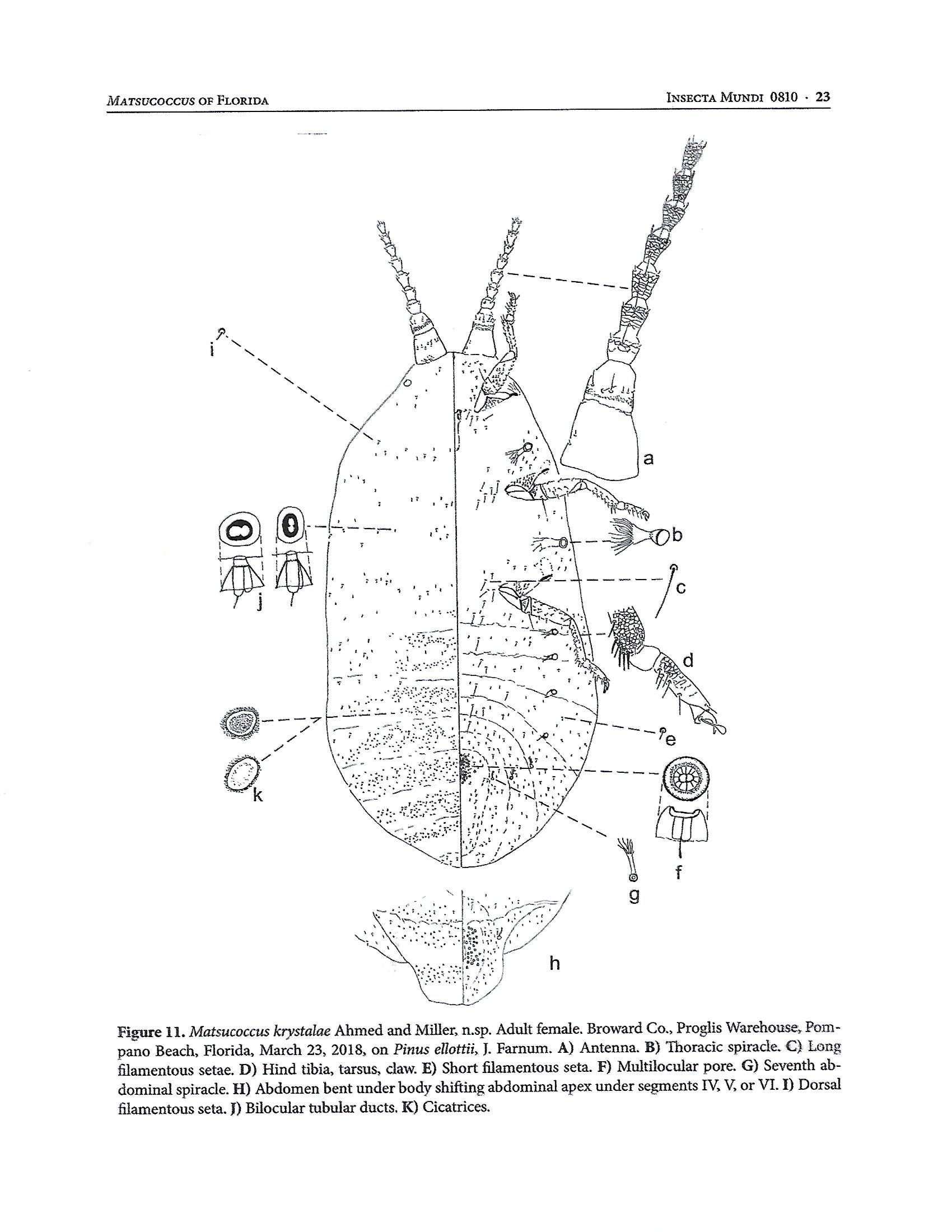Valid Names Results
Matsucoccus krystalae Ahmed & Miller, 2020 (Matsucoccidae: Matsucoccus)Nomenclatural History
- Matsucoccus gallicolus; Morrison 1939: 12. misidentification
- Matsucoccus krystalae Ahmed & Miller 2020: 22. Type data: USA: Florida, St. Lucie Co, Fort Pierce, 2001 Rock Rd., 2/28/2018, by. Holotype, female, by subsequent designation Type depository: Gainesville: Florida State Collection of Arthropods, Division of Plant Industry, Florida, USA; accepted valid name Notes: In addition, there are 145 paratypes deposited in the following collections: AUMNH, CSCA, NHMUK, UCDC, USNM. Illustr.
Common Names
Ecological Associates
Hosts:
Families: 1 | Genera: 1
- Pinaceae
- Pinus | AhmedRaMo2020
- Pinus elliottii | AhmedRaMo2020
Geographic Distribution
Countries: 1
- United States
- Florida | AhmedRaMo2020
Keys
- AhmedRaMo2020: pp.8 ( Adult (F) ) [Eastern U.S.]
Remarks
- Systematics: Adult females of M. krystalae can be separated from M. gallicolus (characters in parentheses are of M. gallicolus) as follows: 437–900 cicatrices (170–378 cicatrices); cicatrices often present on metathorax (not on metathorax); cicatrices present near body margin on one or more posterior abdominal segments (not present near body margin); with 36–72 multilocular pores (20–32 multilocular pores). Adult females of M. krystalae can be separated from M. alabamae (characters in parentheses are of M. krystalae) as follows: Cicatrices present from abdominal segment III to VI (metathorax or segment I to segment VI); setae anterior of hind coxae 10–16 μm long (18–55 μm long); abdominal spiracles approximately same size (7th abdominal spiracle normally smaller than 1st abdominal spiracle); 2–4 setae on venter of first antennal segment (5–9); 7–18 setae on hind femur (16–29). Adult females ofM. krystalae also are similar to M. apachecae Ray and Williams from Arizona but differ from the latter (characters in parentheses are of M. krystalae) by having from 21–45 cicatrices (437–900 cicatrices) present in the medial area of the dorsum (medial, mediolateral, and lateral areas). (Ahmed, et al., 2020) Third-instar males of M. krystalae can be separated from M. alabamae (characters in parentheses are of M. krystalae) as follows: setae anterior of hind coxae 10–16 μm long (20–36 μm long); abdominal spiracles approximately same size (7th abdominal spiracle normally smaller than 1st abdominal spiracle); eight or fewer bilocular tubular ducts on dorsum of abdominal segment III (10 or more). (Ahmed, et al., 2020)
- Structure: Adult female body elongate, parallel sided, 3.1–5.9 mm long, 1.4–2.2 mm wide. Dorsum: Setae uncommon, inconspicuous, arranged in rows, of one size, 8–11 μm long. Bilocular tubular ducts scattered over surface, uncommon on head and within rows of cicatrices; tubes usually slightly divergent. Cicatrices on metathorax (some specimens without or with only one or two) or segment I to segment VI; some segments with cicatrices present near body margin; some anterior segments with separate rows on anterior and posterior sections, anterior rows usually with fewer cicatrices; totaling 437–900; largest 6–12 μm in diameter. Body setae of two distinct sizes; fleshy setae present on distal four antennal segments. (Ahmed, et al., 2020) Third-instar Male: Two sizes of setae on venter, setae anterior of metacoxae about 30 μm long, marginal setae about 12 μm long; with 10 or more bilocular tubular ducts on dorsum of abdominal segment III; abdominal spiracles usually decreasing in size posteriorly; fleshy setae present on distal four antennal segments. (Ahmed, et al., 2020)
- General Remarks: Detailed description and illustrations in Ahmed, et al., 2020.
Illustrations
Citations
- AhmedRaMo2020: DNA, description, diagnosis, host, illustration, key, male, nymph, 22-27



